Click the blue text

Follow us
The premium course “Introduction to Information Science and Technology” (referred to as “Info Course”) at ShanghaiTech University is a mandatory general education course for all first-year students, established at the inception of the university. There are many mysterious legends surrounding the “Info Course” on campus. For students who have just entered university and lack programming foundations, what hardcore knowledge and skills can they gain from it? How will this knowledge assist in their professional studies? What preparations are needed to excel in the “Info Course”? In this issue, we will take you deep into the design philosophy of this course and unveil its mysteries.
What is the design philosophy of the Info Course?
The core philosophy of the “Info Course” is the “Make Course” approach commonly adopted by world-class universities, which can be explained in Chinese as “learning by doing”. By engaging in course projects, students’ curiosity is stimulated, allowing them to apply theoretical knowledge learned in class to practice, which in turn reinforces their understanding of the knowledge.
This course presents the entire landscape of the information discipline to students in an introductory format, helping them establish a basic knowledge framework of information technology, laying the foundation for their subsequent professional courses and research work. The course consists of a total of 64 hours, including theoretical classes and project practice. Among these, 48 hours are dedicated to theoretical classes, and 16 hours to project practice.

Figure | The framework of the theoretical classes of the Info Course
The information discipline at ShanghaiTech includes three major directions: Computer Science and Technology, Information Engineering, and Electronic Science and Technology. Accordingly, when designing the “Info Course”, the instructors laid out three main sections based on the fundamental elements of these three disciplines: Python programming, signal processing, and electrical and electronic engineering.
What do these three sections cover? Let’s hear from the instructors.
Python Programming
Professor Qiu Yue, School of Information

As society transitions to digitalization and informatization, people are surrounded by an ocean of information, and how to quickly and effectively acquire and process data occupies every aspect of life. Python, as the most popular programming language today, has gained widespread application in various fields due to its strong usability, ease of entry, and numerous open-source projects. The best way to learn a programming language is to use it; adhering to the principle of learning by doing, the Python programming section emphasizes hands-on operational skills. The class teaches basic principles, while the assignments focus on learning through practice, with assignments designed to increase in difficulty. Through classroom instruction and assignment training, students develop the ability to use Python to complete basic data acquisition, analysis, and processing tasks. Finally, through course design, students systematically train and improve their practical operational skills, laying the groundwork for future applications of Python in their respective professional fields.
Signal Processing
Professor Zheng Rui, School of Information

The rapid development of digital information technology has permeated every aspect of our lives, with digital signals and digital images being its core content. Learning about these topics is fundamental for further understanding and mastering research methods in information science. This section of the course introduces the basic concepts of digital signals and images, as well as related methods, enabling students to gain a preliminary understanding of what digital signals and images are, and how to process and apply them to meet final requirements. The teaching process follows a three-step learning sequence: first, through classroom lectures, students learn abstract concepts and theories; second, in exercise classes, they practice programming while thinking critically to reinforce their understanding; finally, through assignments, they continue self-learning, exploring how to apply theoretical knowledge to practical situations, effectively integrating theory and practice. Through course training, students not only learn relevant foundational knowledge and basic methods but also understand how to apply this knowledge to solve practical problems, laying a solid foundation for future applications in information science.
Electrical and Electronic Engineering
Professor Wang Haoyu, School of Information
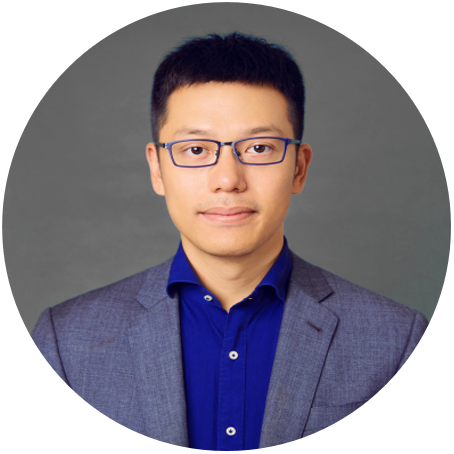
Energy and information are two main lines running through the development of human civilization, corresponding to electrical engineering and electronic engineering in the field of information. Electronic devices are the most important infrastructure of the information age, and the transistor is the core component of electronic devices. The electrical and electronic engineering section revolves around the concept of the transistor. It first explains the contributions of electrical and electronic engineering to human civilization from a macro perspective, and then unravels three core questions from the perspectives of devices, circuits, and systems: how to manufacture transistors from sand? How to use transistors to build digital, analog, and power circuits? How to use functional circuits to build a practical system?
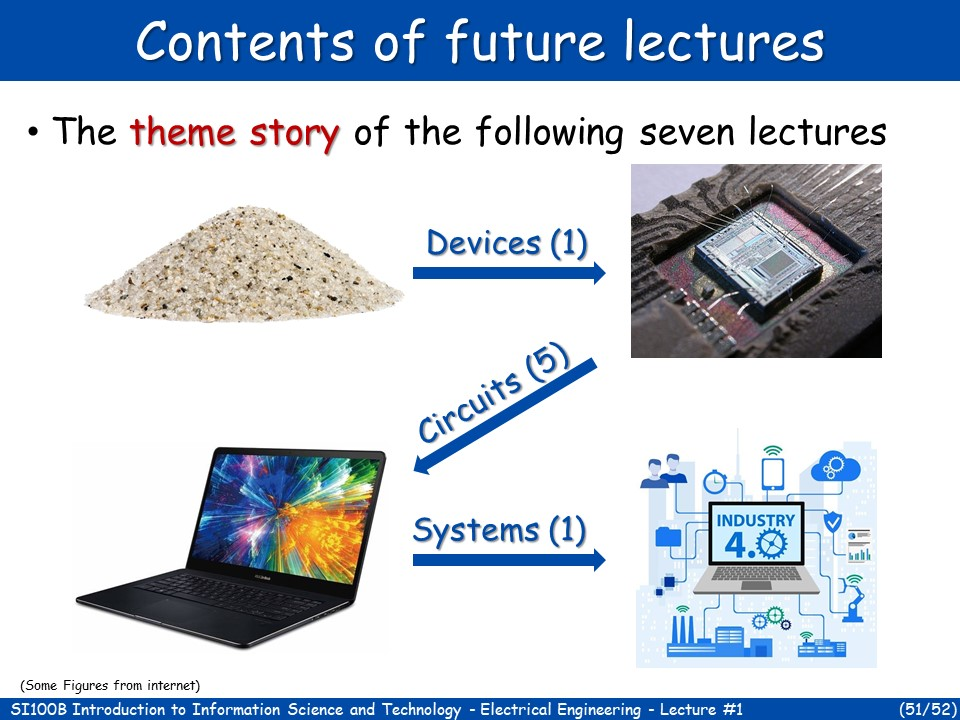
Figure | The design logic of the electrical and electronic engineering section
Additionally, in response to the learning and research characteristics of students from the School of Life Sciences, the teaching team adjusted the theoretical classes of the “Info Course” to include three parts: Python programming, signal processing, and biological applications. The biological applications section introduces interdisciplinary content related to bioinformatics, drug design, biological image processing, and artificial intelligence, taught collaboratively by professors Zheng Jie, Gao Shenghua from the School of Information, and Bai Fang, Zhang Liye, Li Xiaoming from the School of Life Sciences.
The above mainly introduces the design logic and key points of the theoretical course, while the core of the course, which accounts for the highest proportion (40%), is the project practice segment. In the spring of 2022, to accommodate individual differences among students, the teaching team carefully designed six parallel project topics, all of which are team projects. Students can form three-person teams based on their professional backgrounds and interests, choose a topic, and complete unique course projects through hands-on practice.
Next, let’s take a look at the projects provided by the teaching team!
1
Social Exploration Based on Data Processing
This project is guided by Professor Qiu Yue, requiring students to use Python to complete “Social Exploration Based on Data Processing”. Within this framework, students can choose their topics freely, fully exercising their ability to extract key information and process and analyze data using Python tools. To reinforce the teaching content while balancing practicality and openness, the project tasks adopt a unique parallel mode of “practice” and “task completion”. In the practice phase, students will read specific problems and use Python to derive concrete results, familiarizing themselves with the application of programming in data science, so they can apply this knowledge in the project. The task completion phase requires students to extract data from social phenomena, derive information from the data to guide their direction, encouraging open exploration and creativity to produce unique projects.

The research topic of this group is “The employment situation of WOMEN in the STEM industry in China”. By analyzing existing online data, they examined the proportion of female tech talent in STEM and predicted the future employment trends of women in technology in China.
2
Car-mounted Type-C Charger
Type-C charging has become ubiquitous, allowing us to conveniently power various electronic devices such as smartphones, tablets, laptops, and headphones. Under the guidance of Professor Wang Haoyu, students are required to build a car-mounted Type-C charger using components such as transistors, diodes, capacitors, and inductors.
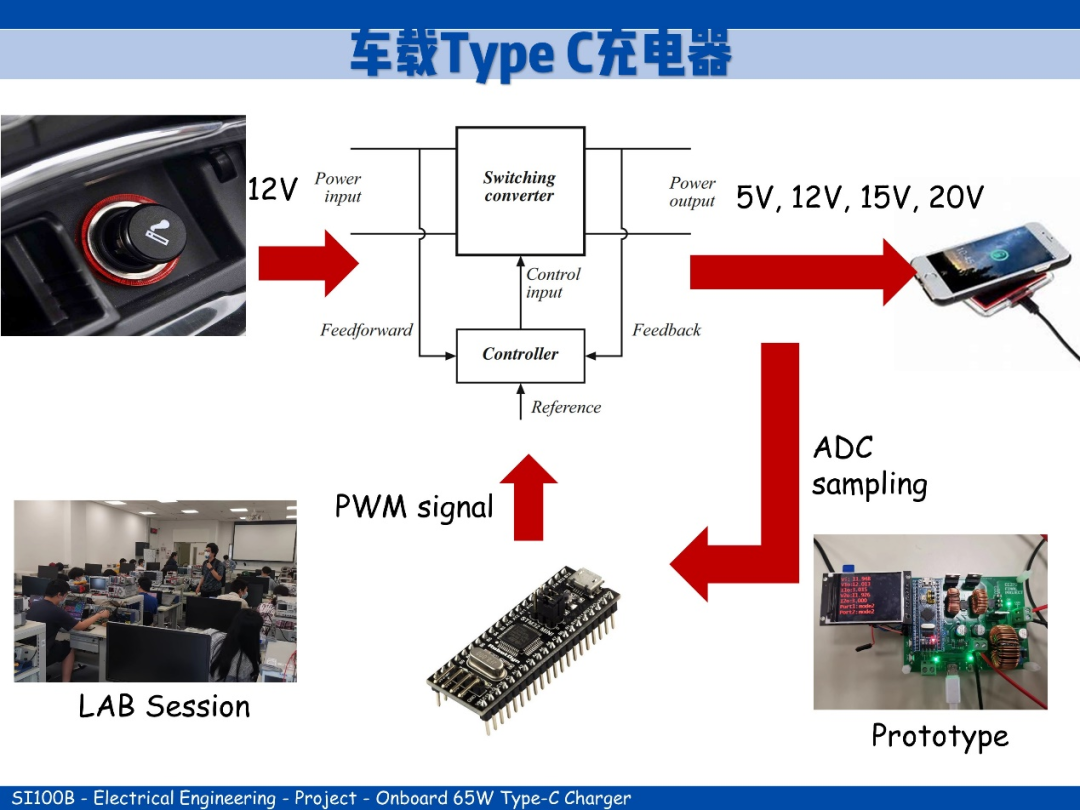
In this project, students need to complete electronic system design, system parameter optimization, circuit simulation, system assembly, and delivery. This process helps students learn basic embedded programming, read circuit diagrams, master soldering skills, and become familiar with the use of electronic instruments. More importantly, it trains students’ problem-solving abilities. The basic elements of this project closely align with the theoretical knowledge in the electrical and electronic engineering section, guiding students to reinforce their understanding of theoretical knowledge through engineering practice.
3
Handwritten Digit Recognition System
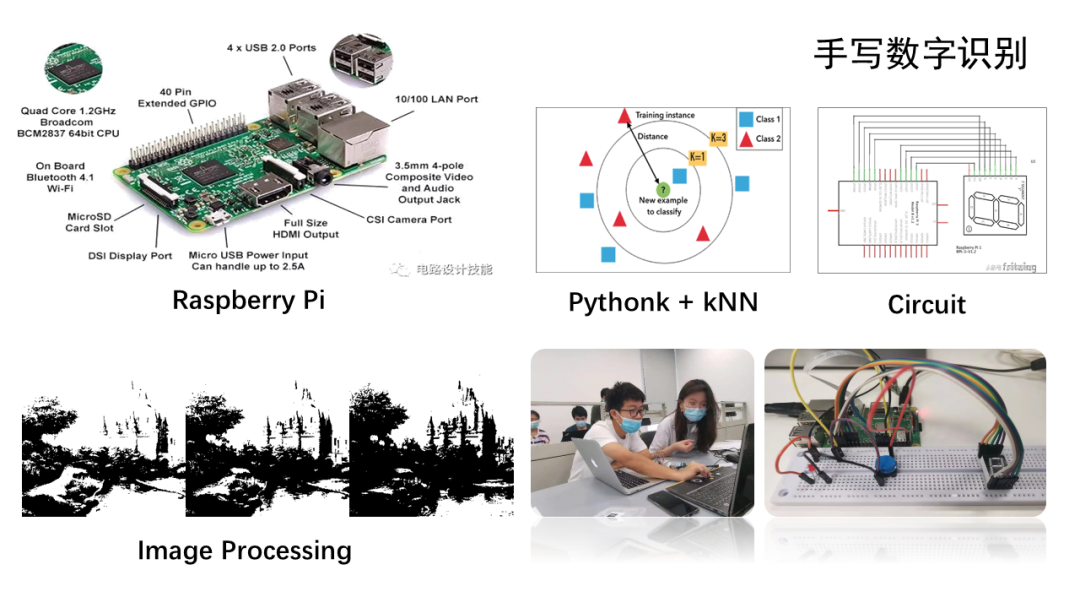
The handwritten digit recognition system uses a Raspberry Pi with a camera module as the hardware platform, and Python as the programming language. After preprocessing the images, it combines algorithms such as kNN and neural networks to ultimately recognize the digits in the captured handwritten images. This project is led by teacher Lu Linyan, aiming to introduce students to the field of intelligent recognition in artificial intelligence and stimulate their research interests.
4
Smart IoT Terminal
With the rapid development of IoT technology, the world has entered an era of interconnected devices. The IoT connects various items in life through embedded systems, networks, and sensors, enabling each item to have observability and controllability within the IoT. Students can learn about the status of various items through the IoT and control their states.
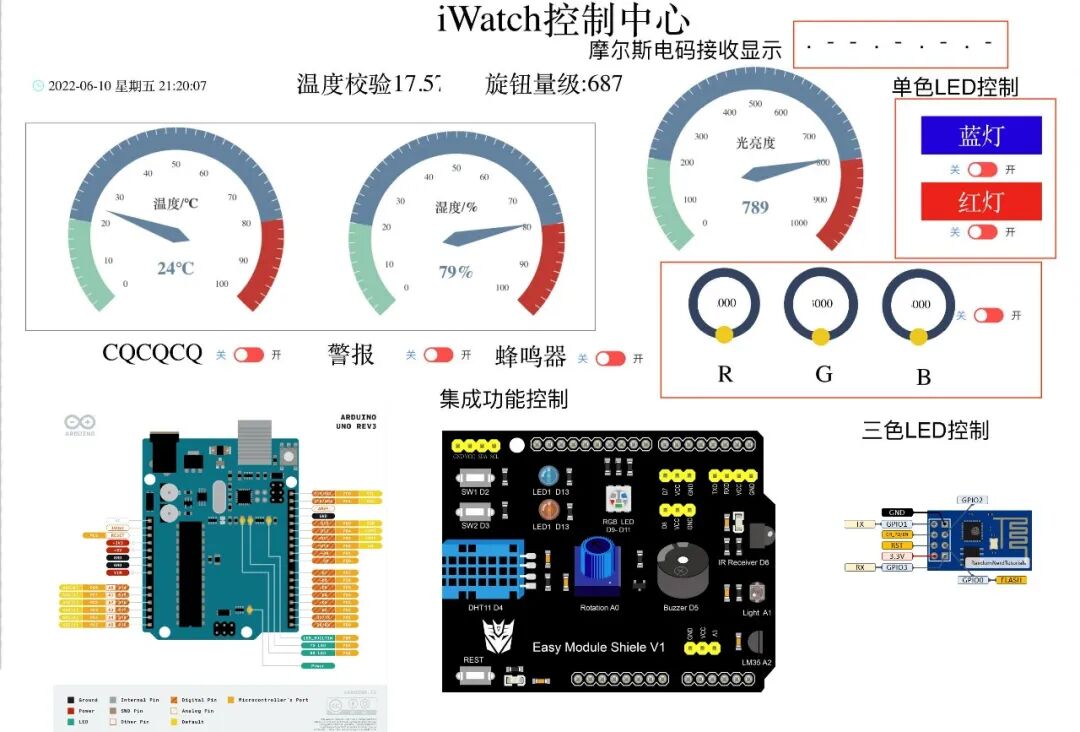
Under the guidance of teacher Liu Chuang, the group combined Arduino with the ESP8266 module to achieve remote data transmission and monitoring on the OneNet IoT platform, which can also be applied in scenarios such as fire alarms, dormitory remote locks, and remote-controlled cars. This project allows students to learn about embedded micro-systems, various types of sensors, Wi-Fi networking, and IoT control terminals, and enhances their ability to integrate software and hardware through coding and hardware debugging.
5
Biological Image Processing
High-content imaging technology enables high-speed microscopic imaging and rapid analysis of massive image information, allowing tasks that previously took a lot of time and effort to be completed instantly. It is widely used in targeted drug screening and pharmacological toxicity analysis, and the project is guided by Professor Zheng Rui.
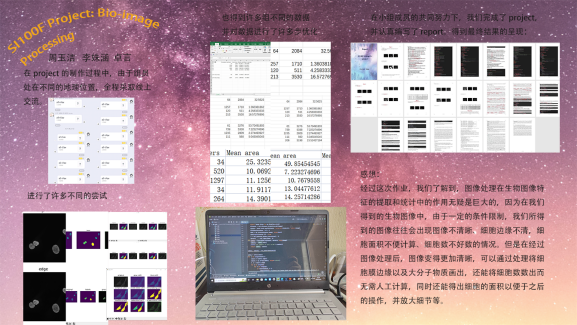
The group’s project topic is “Bio-image processing”. They used a high-content imaging platform to complete the separation of the cytoplasm and nucleus of individual cells and analyzed the number and area of characteristic structures distributed in the nucleus and cytoplasm.
6
Computer-Aided Drug Design
The project of the computer-aided drug design module aims to cultivate and enhance students’ application abilities in biomedical big data mining and basic methods of drug design. The project is guided by Professor Bai Fang.

The group focused on the cancer target MCL-1, conducting data mining on over 1,000 active compounds and activity data of varying quality, obtaining high-quality compounds and efficacy data, establishing a structure-activity relationship model, summarizing key efficacy characteristics targeting MCL-1, and further using methods such as molecular docking to intuitively analyze the molecular interactions of active compounds with the MCL-1 target, proposing drug optimization strategies and cultivating drug design concepts and logical thinking.
What is the biggest challenge in learning the Info Course?
For freshmen, the biggest challenge is the need to complete the transition from high school to university learning paradigms. Compared to the rote learning of high school, university learning emphasizes students’ autonomy. Additionally, in project practice, we place special emphasis on students’ teamwork abilities and hands-on problem-solving skills.

Accordingly, the course design of the “Info Course” also emphasizes comprehensive assessment throughout the process. There is no final exam; grades are distributed throughout the semester. Python programming (20%) + signal processing (20%) + electrical and electronic engineering (20%) + Project (40%). The theoretical class grades are determined by quizzes, homework, and other components.
Compared to the traditional model of a single exam determining one’s future, process-oriented assessment may make students feel more burdened, but it eliminates the need for “cramming before exams”, and the mastery of knowledge becomes more solid and lasting. For students who excel, we also offer bonus credits to showcase their talents.
Showcase of the Info Course’s Popular Science Works
1
Flexible Screen:
2
Photodiode:
To help students adapt to the transition in learning methods, in addition to theoretical classes, we have designed tutorial sessions and open office hours to answer students’ questions as they progress through the theoretical classes and assignments. Through extensive after-class guidance and Q&A, we can not only address difficult knowledge points that were not fully understood in class but also allow students to provide feedback on their learning experiences to the teaching assistants and instructors, facilitating real-time adjustments to the teaching plan and content.
Learning Reflections from the Class of 2021
Starting from topic selection, through planning, division of labor, practice, and correction, a complete course project was formed. The students in the group not only applied course knowledge continuously but also honed their collaborative skills, gaining a lot.
Zhuo Pu, a 2021 undergraduate from the School of Materials, said: “This semester’s Info experimental course sparked my strong interest in Arduino. In class, I controlled LED lights and buzzers with buttons, and used temperature and light sensors in conjunction with other hardware to achieve many interesting functions. In the final course project, I completed the IoT functionality for temperature and humidity detection. During the debugging process, although the teacher provided us with some code, many unpredictable problems still arose during actual operation. ‘What is learned on paper is shallow; true understanding comes from practice.’ I feel that this experimental course has given me a deeper experience of this saying.”
Xu Yunfei, Lu Jiali, and Tan Yingjie, 2021 undergraduates from the School of Life Sciences, stated: “Through this assignment, we learned that image processing plays a significant role in extracting and statistically analyzing biological image features. Due to certain constraints, the biological images we obtained had various issues such as unclear images and indistinct cell edges. However, after image processing, the images became clearer, allowing us to outline cell membrane edges and large molecular substances, and also obtain cell areas for subsequent operations, which was immensely beneficial.”
Fan Youle, a 2021 undergraduate from the School of Life Sciences, said: “Completing project practice in a new field while ‘feeling my way across the river’ was a process filled with setbacks and challenges. Looking back, our three-person group gradually learned to divide tasks and leverage our strengths over these three weeks. We not only mastered the basic methods of screening inhibitors and analyzing interaction patterns but also gained valuable friendships in the process!”
Shi Wenjia, a 2021 undergraduate from the School of Creative Arts, said: “This Python project practice not only taught us a lot of theoretical knowledge, including how to collect, process, and analyze data to achieve our desired results, but also allowed us to experience firsthand how reasonable division of labor and active collaboration in group actions can yield results beyond our imagination. We believe these gains will also benefit our future academic and professional careers.”
Shi Ruitian, a 2021 undergraduate from the School of Management, said after completing the project: “Through a month of course study, my interest in Raspberry Pi was ignited. First, the learning content was rich and interesting. The teacher’s explanations were gradual, and with the help of teaching assistants, I learned solid foundational knowledge. Secondly, the course design fully considered the knowledge reserves of undergraduates and integrated them with future practical applications, enhancing my programming skills while also giving me a new understanding of mathematics. Through this course, I gradually realized that learning is not just about deriving formulas and reproducing code, but also has very broad and crucial applications in real-world scenarios, which has greatly benefited me.”
After eight years of refinement and improvement, the Info Course has become one of the most memorable courses mentioned by graduates.
The Info Course not only teaches students hardcore knowledge and skills but also hones their willpower, teaching them to face difficulties bravely.
“The goal is right there; use all your strength to reach it! The professors constantly push us out of our comfort zones,” said Xie Zhiqiang, a 2022 alumnus from the School of Information (who will pursue a PhD at Stanford University), during the 2019 graduation ceremony, reflecting on the impact of the Info Course on him. He said, “Although this led to more confusion and difficulties than others, it also released more potential, teaching me to be fearless in the face of uncertainty, to find direction in the midst of confusion, and to learn the art of survival through teamwork.”
Chen Ziling, a 2018 graduate from the School of Life Sciences, also stated, “The Info Course made students fully understand the necessity of self-learning at the beginning of their studies, mastering how to excel under pressure through assignments and exams, and fully exploring students’ potential to withstand pressure. It has also helped in the formation of procedural thinking.”
The Info Course conveys the concept of interdisciplinary learning, encouraging non-major students to acquire foundational skills in information technology, further expanding their research methods and ideas in their respective fields.
Chen Xiangning, a 2020 graduate from the School of Life Sciences, currently pursuing a PhD at Johns Hopkins University, recalled his experience during his undergraduate exchange at Harvard University in the “3+1” program, writing: “My work at Harvard focused on behavioral experiments and sidewall projection technology, which required extensive use of programming and mathematical knowledge. I must say, I am very grateful that the Info Course at ShanghaiTech allowed me to master programming skills in advance. Although it was very challenging to learn with almost zero foundation, and I had to consult the teacher every day, it really came in handy at critical moments and even became my advantage.”
The Info Course has opened a window for students, allowing more non-major students to experience the unique charm of information science.
Chen Yifan, a 2018 graduate now working at Oracle in the United States, reflected on his undergraduate studies, stating that the Info Course laid the foundation for his learning, and it was precisely because he was exposed to Python in the Info Course that he discovered his strong interest in information science, leading him to choose computer science-related research topics in graduate school.
Qu Xinyue, a 2017 undergraduate, also remarked, “Looking back now, the Info Course actually provided me with a window to access computer languages, guiding me through the process from installing Python, configuring VS Code, to writing simple but functional programs. This made me more willing to use tools like Matlab and LaTex in my subsequent research work, knowing where to find tutorials and resources to achieve a function… Of course, besides Python, the Info Course also introduced us to many other topics, such as sensing, CV, chips, etc., providing a knowledge base for continuously understanding cutting-edge developments in this field.”
With this introduction, I believe everyone now has a preliminary understanding of this course. We look forward to all students enjoying the learning process of the Info Course, achieving success, and applying what they have learned.
Edited byGao Zhengchun
Gao Xuan

Have you “shared”, “liked”, or “viewed” today?